The Salinas River is the 9th-longest in California. This river flows from the Los Machos Hills in the Los Padres National Forest for 175 miles before reaching Monterey Bay and the Pacific Ocean. Many animals live in and around the river as it travels through western California. Today, we’re going to focus on the snakes of the Salinas River, showing you a variety of the slithering reptiles that occupy this area. Learn which snakes you can see in this area and which ones you need to be especially careful around because they’re venomous!
1. California Kingsnake

California kingsnakes (
Lampropeltis californiae) are called kingsnakes because they sometimes eat other snakes.
©Creeping Things/Shutterstock.com
First on the list, we have the California kingsnake, Lampropeltis californiae. These snakes typically have bands of light and dark color on their bodies, but their color schemes can vary quite a bit. These reptiles often grow between 30 and 40 inches or even longer.
Like other kingsnakes, this species feeds on other snakes, even venomous ones. Of course, they’ll also eat other creatures like small mammals and birds.
2. Northern Rubber Boa
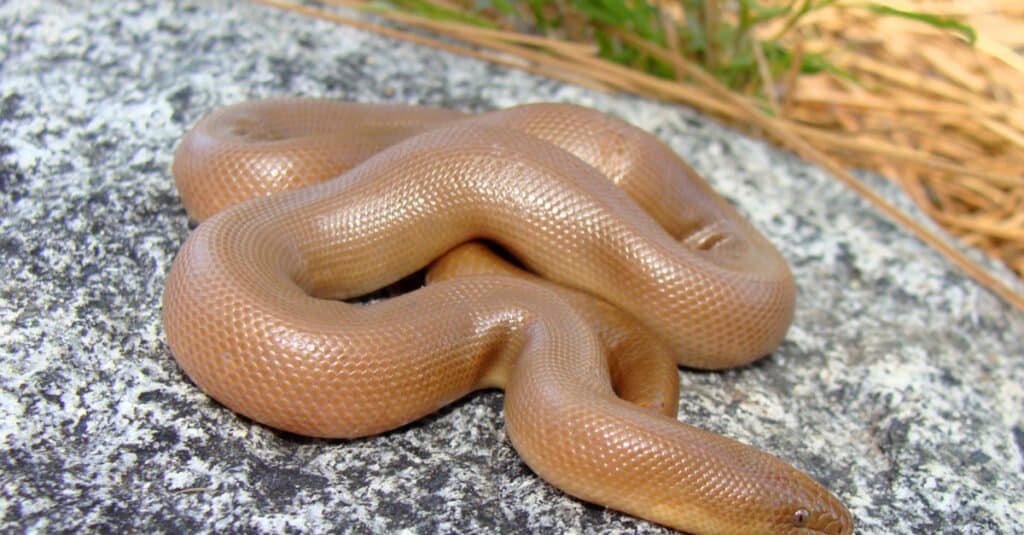
Rubber boas are true to their name with their rubbery appearance.
©Matt Jeppson/Shutterstock.com
The northern rubber boa, Charina bottae, is a somewhat small snake that often measures between 12 and 36 inches long. These snakes are known for their unique looks which include loose skin and small, shiny scales that make them look as though they’re made from rubber.
The species may exhibit colors like tan, gray, or brown with a yellow or cream-colored underside. They pose no threat to people, and they’re known for being especially docile.
3. Pacific Gopher Snake

The Pacific gopher snake flattens its head and shakes its tail when threatened.
©Eric Isselee/Shutterstock.com
The Pacific gopher snake is another one of the snakes of the Salinas River. The reptile’s scientific name is Pituophis catenifer catenifer, and it is a subspecies of constrictor snake. These snakes may look like a rattlesnake at first glance because they have a brown or yellow body with various patches of darker colors.
Part of their threat response involves flattening their heads and shaking their tails, somewhat mimicking a rattlesnake. However, these snakes are not venomous or dangerous to humans, but they can scare people.
4. Western Rattlesnake
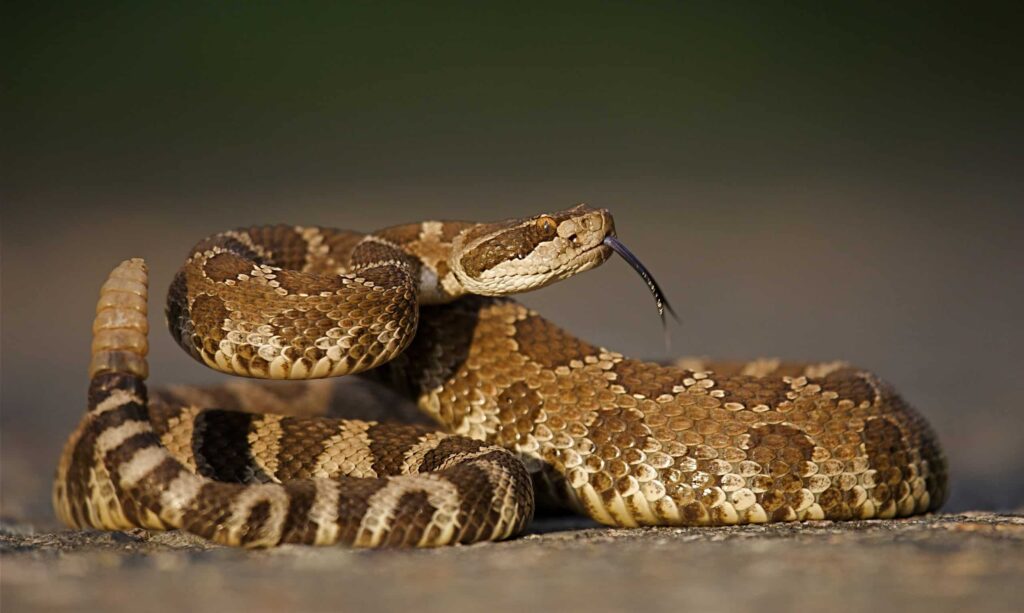
The western rattlesnake is one of the venomous snakes found in the Salinas River area.
©Tom Reichner/Shutterstock.com
Crotalus oreganus is a species with two common names: the western rattlesnake and the northern Pacific rattlesnake. The western rattlesnake is a venomous species capable of delivering a medically significant bite to human beings. So, they’re one of the few snakes of the Salinas River that pose a serious threat to human life.
They appear in many colors including brown or olive, often featuring dark spots surrounded by a lighter color. The snake has a thick body, a wide head, and a rattle at the end of its tail. These snakes are more likely to flee than attack if a human encounters them. However, if a person accidentally steps on them or tries to handle them, then the snake may strike.
5. Ring-Necked Snake

The northern ring-necked snake can be identified by its black or gray body and yellow or orange band near its head.
©CampSmoke/Shutterstock.com
The ring-necked snake, Diadophis punctatus, is a small species of snake. They often measure between 10 and 15 inches, but they can reach sizes of about 20 inches. The snakes often have a gray or black body with a colorful yellow or orange band near their heads along with a red, orange, or yellow underside. These snakes have a weak venom that is no threat to humans.
6. Aquatic Garter Snake
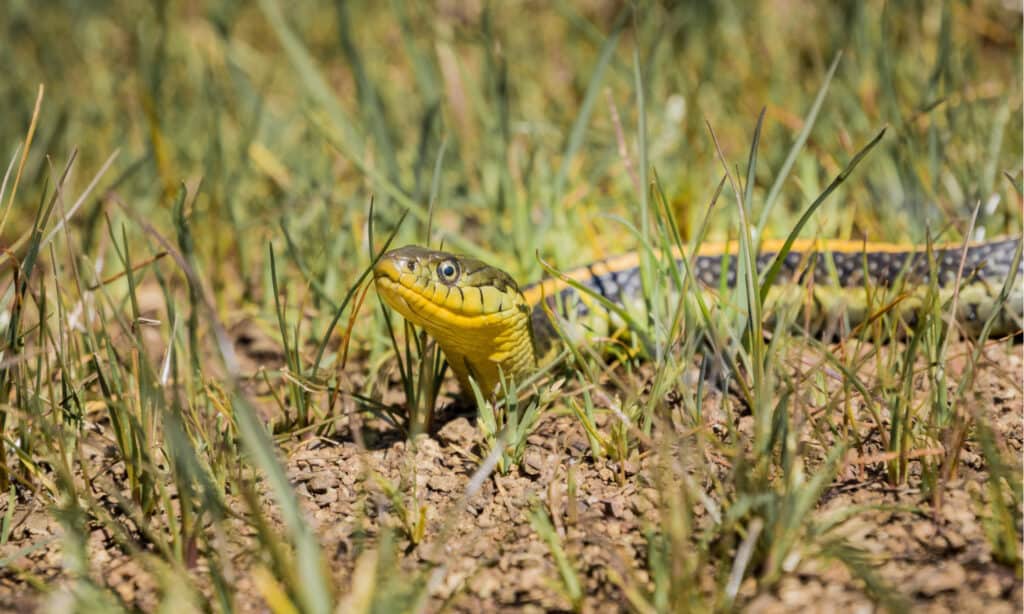
An aquatic garter snake can reach 40 inches in length.
©Sundry Photography/Shutterstock.com
The aquatic garter snake, Thamnophis atratus, is a species of snake known for living near bodies of water, often streams, ponds, or lakes. The species has many color variants that include a dark body that may or may not have a long yellow or cream-colored stripe running down the length of its body. These snakes usually grow between 16 and 40 inches in length.
7. Western Terrestrial Garter Snake
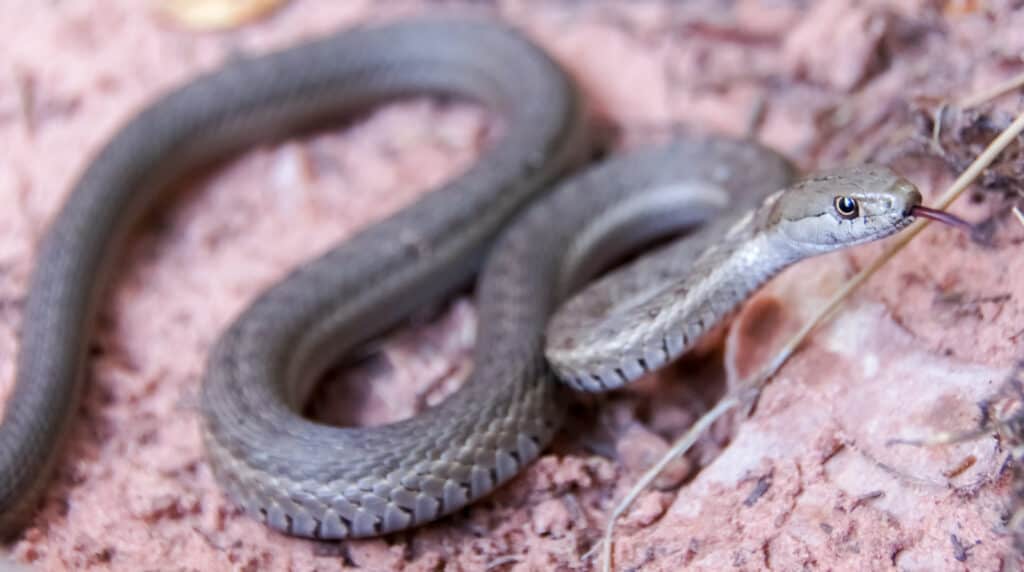
The western terrestrial garter snake can be found near streams that feed into the Salinas River.
©iStock.com/yhelfman
The western terrestrial garter snake (Thamnophis elegans) is a snake that measures between 18 and 40 inches in total length. Although these snakes have weak venom, it is not dangerous to humans in the vast majority of cases. The western terrestrial garter snake can appear with many different colors that make this species hard to identify at a glance. The snakes survive in many environments, but they can be found near water sources, including the streams that feed into the Salinas River.
8. Striped Racer

Striped racers have been known to reach 6 feet.
©Matt Jeppson/Shutterstock.com
The striped racer (Masticophis lateralis) is also called the California whipsnake. These snakes are thin and often have black or brown bodies with a cream or yellow stripe on either side of their backs. The snakes often grow between 3 and 4 feet in length. These snakes are not venomous, but they can quickly strike. They eat prey such as lizards, birds, and smaller mammals.
9. Sharp-Tailed Snake

The sharp-tailed snake gets its name from the sharp spine found on the end of its tail.
©Bill Bouton / CC BY-SA 2.0 – License
The sharp-tailed snake (Contia tenuis) is one of the smaller snakes of the Salinas River. On average, these snakes only grow between 12 and 18 inches in length. The snakes can appear in many different colors including brown, dark red, and even orange with a black and white belly. The snake’s common name comes from the sharp spine it has on the end of its tail. Don’t worry; this part of the snake’s anatomy cannot hurt a human, and it does not inject venom. Scientists think it helps the snake hold its prey in place so the snake can eat it.
10. Long-Nosed Snake
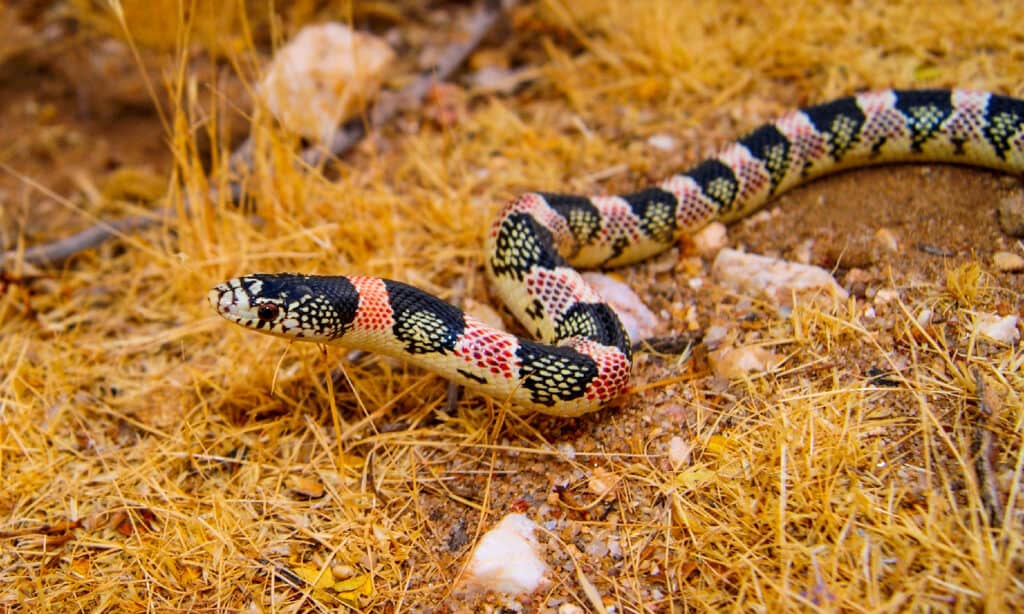
The long-nosed snake may look venomous, but it is not.
©Matt Jeppson/Shutterstock.com
Rhinocheilus lecontei, the long-nosed snake, is a non-venomous snake known for its unusually long snout. The snake often has a black, yellow, and red coloration, a color scheme that resembles the venomous coral snake. The long-nosed snake is not venomous, though. These snakes often grow between 20 and 32 inches as adults. They usually prefer to live in rocky areas or rodent burrows. So, the snake’s range is near the Salinas River, but most people won’t see this snake if they stay near the body of water.
11. California Night Snake
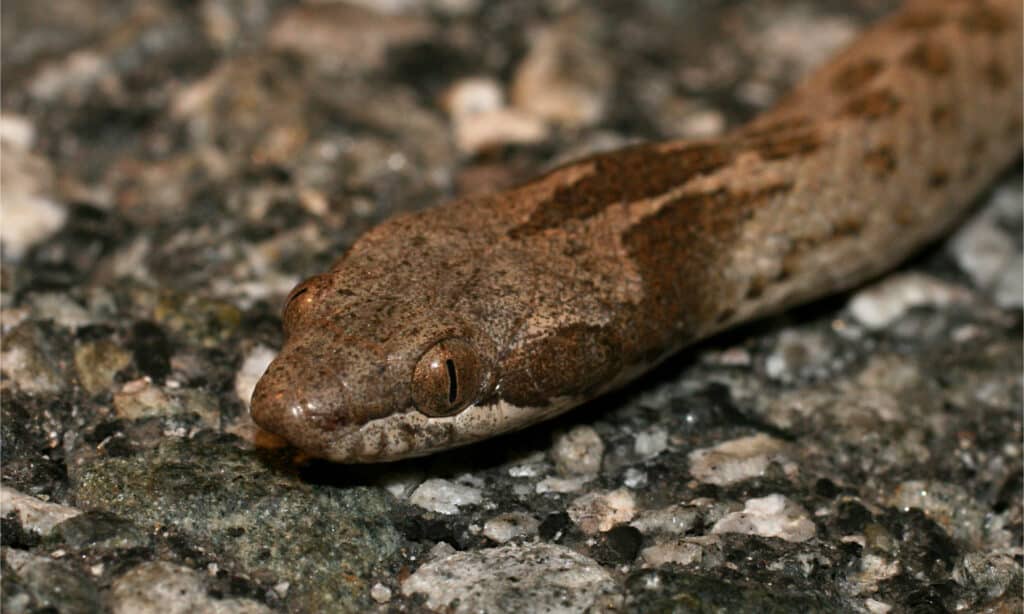
Night snakes are so named because they hunt at night.
©Casey K. Bishop/Shutterstock.com
The California night snake (Hypsiglena ochrorhynchus nuchalata) is another one of the small snakes of the Salinas River. These snakes grow between 12 and 26 inches long, and they are venomous. While this snake is venomous, its venom is not dangerous to humans.
Instead, this mild venom simply helps the reptiles while they’re hunting their prey. The snakes are usually light brown, light gray, or tan with gray or dark brown marks on their body. These snakes are nocturnal, part of the reason for their common name.
12. North American Racer
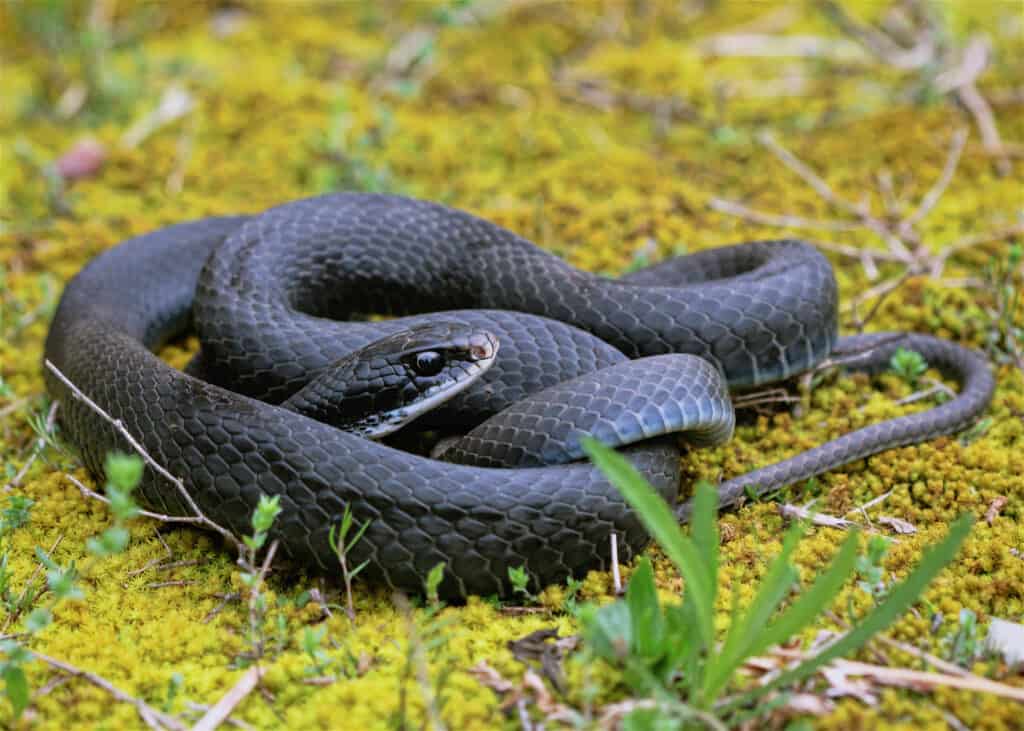
Racers eat small animals like rodents, frogs, toads, lizards, birds, and bird eggs.
©Matthew L Niemiller/Shutterstock.com
The North American racer (Coluber constrictor) is also known as the eastern racer. Despite the latter name, the species lives throughout vast swaths of California, including the area around the Salinas River. These snakes can measure anywhere from 20 to 62 inches or even more.
These quick-moving snakes can exhibit many different colors. Although they’re not venomous, they’ll move their tails rapidly when cornered to make people think they’re rattlesnakes! While these snakes won’t chase a person down to bite them, they’ll strike defensively.
13. Coast Mountain Kingsnake
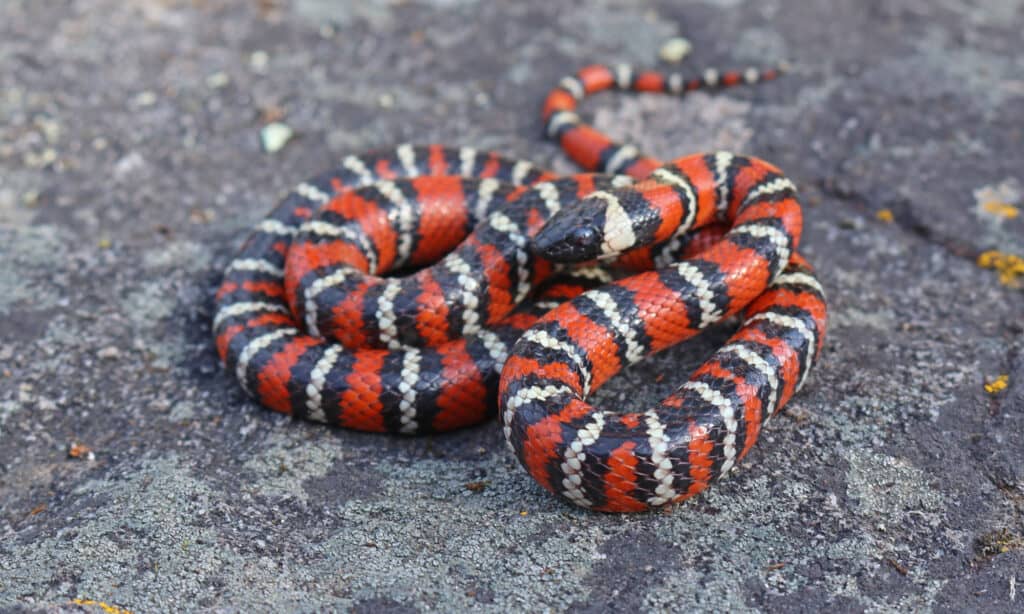
This snake species also looks like a coral snake, but it is not venomous.
©Creeping Things/Shutterstock.com
The coast mountain kingsnake (Lampropeltis multifasciata) is a species of snake distinct from the closely related California mountain kingsnake. This species looks similar to coral snakes with red, yellow, and black band patterns on its body. However, they are not venomous like coral snakes. The snakes often measure between 21 and 50 inches in total length.
These snakes of the Salinas River live in the counties through which the river flows. Travelers that hike near the river may encounter other snakes. It’s a wise idea to leave snakes to their own devices, especially if you cannot identify them. While venomous snakes are rare in this area, any snake bite can be unpleasant and painful.
Summary of the Snakes of the Salinas River
| Rank | Snake | Is It Dangerous to Humans? |
|---|---|---|
| 1. | California King Snake | No |
| 2. | Northern Rubber Boa | No |
| 3. | Gopher Snake | No |
| 4. | Western Rattlesnake | Yes |
| 5. | Ring-Necked Snake | No |
| 6. | Aquatic Garter Snake | No |
| 7. | Western Terrestrial Garter Snake | No |
| 8. | Striped Racer | No |
| 9. | Sharp-Tailed Snake | No |
| 10. | Long-Nosed Snake | No |
| 11. | California Night Snake | Has mild venom, but it is not dangerous to humans |
| 12 | North American Racer | No |
| 13 | Coast Mountain Kingsnake | No |
The photo featured at the top of this post is © Matt Jeppson/Shutterstock.com
Discover the "Monster" Snake 5X Bigger than an Anaconda
Every day A-Z Animals sends out some of the most incredible facts in the world from our free newsletter. Want to discover the 10 most beautiful snakes in the world, a "snake island" where you're never more than 3 feet from danger, or a "monster" snake 5X larger than an anaconda? Then sign up right now and you'll start receiving our daily newsletter absolutely free.
Thank you for reading! Have some feedback for us? Contact the AZ Animals editorial team.






